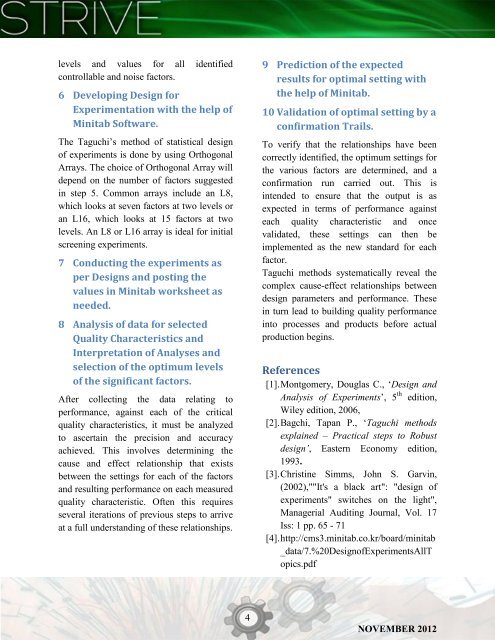sTRIVE final.pdf
Create successful ePaper yourself
Turn your PDF publications into a flip-book with our unique Google optimized e-Paper software.
levels and values for all identified<br />
controllable and noise factors.<br />
6 Developing Design for<br />
Experimentation with the help of<br />
Minitab Software.<br />
The Taguchi’s method of statistical design<br />
of experiments is done by using Orthogonal<br />
Arrays. The choice of Orthogonal Array will<br />
depend on the number of factors suggested<br />
in step 5. Common arrays include an L8,<br />
which looks at seven factors at two levels or<br />
an L16, which looks at 15 factors at two<br />
levels. An L8 or L16 array is ideal for initial<br />
screening experiments.<br />
7 Conducting the experiments as<br />
per Designs and posting the<br />
values in Minitab worksheet as<br />
needed.<br />
8 Analysis of data for selected<br />
Quality Characteristics and<br />
Interpretation of Analyses and<br />
selection of the optimum levels<br />
of the significant factors.<br />
After collecting the data relating to<br />
performance, against each of the critical<br />
quality characteristics, it must be analyzed<br />
to ascertain the precision and accuracy<br />
achieved. This involves determining the<br />
cause and effect relationship that exists<br />
between the settings for each of the factors<br />
and resulting performance on each measured<br />
quality characteristic. Often this requires<br />
several iterations of previous steps to arrive<br />
at a full understanding of these relationships.<br />
9 Prediction of the expected<br />
results for optimal setting with<br />
the help of Minitab.<br />
10 Validation of optimal setting by a<br />
confirmation Trails.<br />
To verify that the relationships have been<br />
correctly identified, the optimum settings for<br />
the various factors are determined, and a<br />
confirmation run carried out. This is<br />
intended to ensure that the output is as<br />
expected in terms of performance against<br />
each quality characteristic and once<br />
validated, these settings can then be<br />
implemented as the new standard for each<br />
factor.<br />
Taguchi methods systematically reveal the<br />
complex cause-effect relationships between<br />
design parameters and performance. These<br />
in turn lead to building quality performance<br />
into processes and products before actual<br />
production begins.<br />
References<br />
[1]. Montgomery, Douglas C., ‘Design and<br />
Analysis of Experiments’, 5 th edition,<br />
Wiley edition, 2006,<br />
[2]. Bagchi, Tapan P., ‘Taguchi methods<br />
explained – Practical steps to Robust<br />
design’, Eastern Economy edition,<br />
1993.<br />
[3]. Christine Simms, John S. Garvin,<br />
(2002),""It's a black art": "design of<br />
experiments" switches on the light",<br />
Managerial Auditing Journal, Vol. 17<br />
Iss: 1 pp. 65 - 71<br />
[4]. http://cms3.minitab.co.kr/board/minitab<br />
_data/7.%20DesignofExperimentsAllT<br />
opics.<strong>pdf</strong><br />
4<br />
NOVEMBER 2012







